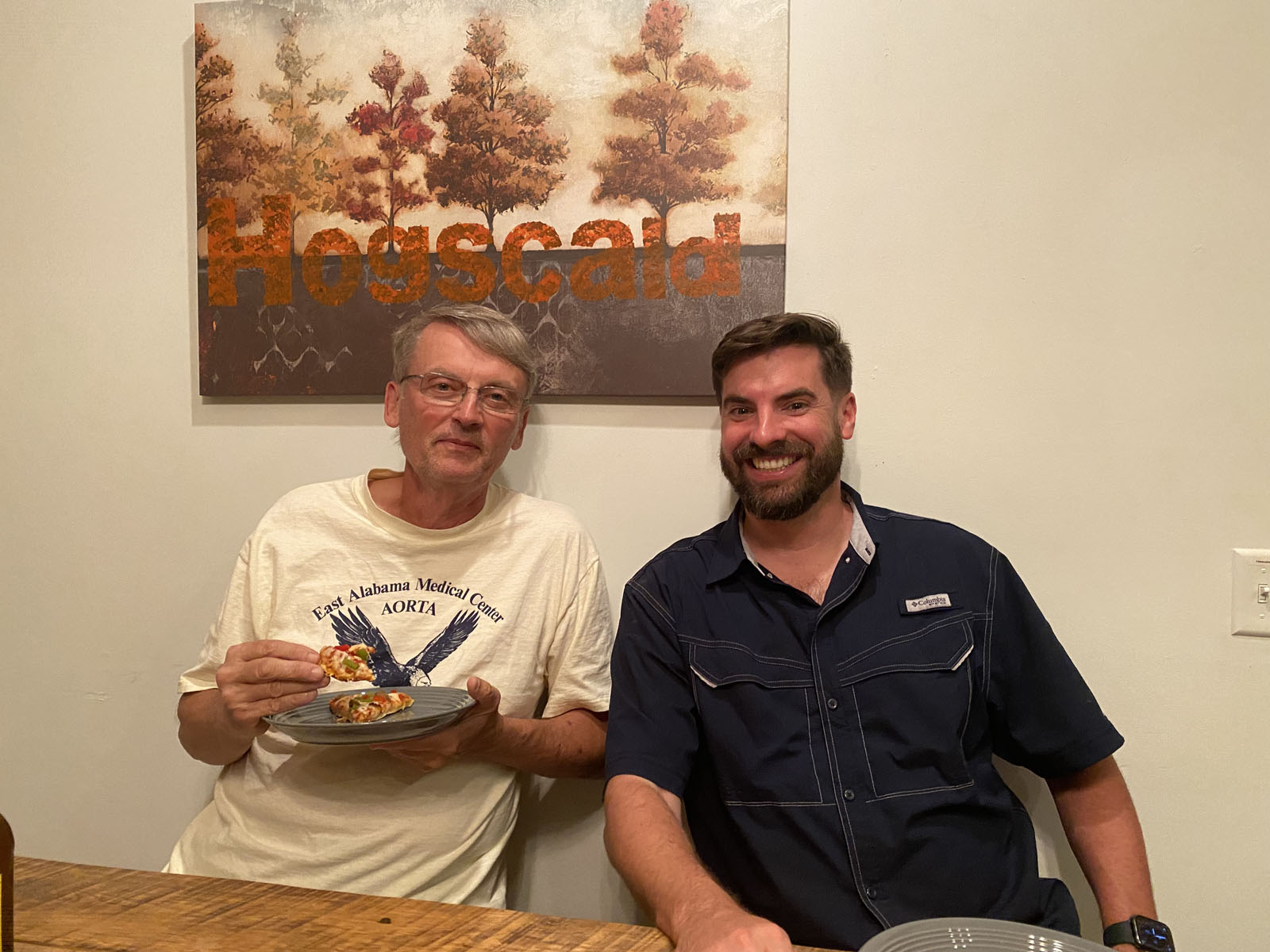William H. Cross Expedition to the Ozark Mountains in Arkansas and southern Missouri, July 18-22, 2022
by J. A. MacGown, uploaded on 26 August 2022
The 2022 William H. Cross Expedition took place from 18 to 22 July 2022 in the Ozark Mountain region of northwestern Arkansas and into southwestern Missouri. We were centered in the Eureka Springs area and stayed in a large Air BnB rental house in Packard Springs Township in Carroll County, Arkansas.
The participants for this year’s expedition included JoVonn Hill (MEM Director, grasshopper specialist), Richard Brown (MSU emeritus professor, Lepidoptera specialist), Joe MacGown (MEM, retired, ant specialist), Dan Otte (Philadelphia Academy of Sciences, grasshopper specialist), Charles Ray (MEM researcher), Joe Sweeney (camel cricket enthusiast), Ray Fisher (MEM researcher, naturalist), Zach Brown (MEM, Master’s student, ants), Landon Hawk (MSU undergrad), and Graham Moore (summer intern/student from Berry College, GA).

2022 William H. Cross Expedition participants: (back row left to right) Dan Otte, JoVonn Hill,
Zach Brown, Landon Wolf, Graham Moore, Ray Fisher, (front row left to right) Joe MacGown,
Joe Sweeney, Richard Brown, and Charles Ray.
Monday, 18 July 2022: Members of expedition arrived late afternoon, and it was not long before we had unloaded our gear. Our rental house was well suited for 10 entomologists, and it was located at a beautiful location on a bluff overlooking a narrow fingerlike projection of Beaver Lake. The habitat was open hardwood forest with scattered cedars near the bluff edges, grassy glade-like openings, and large boulders with overhangs.
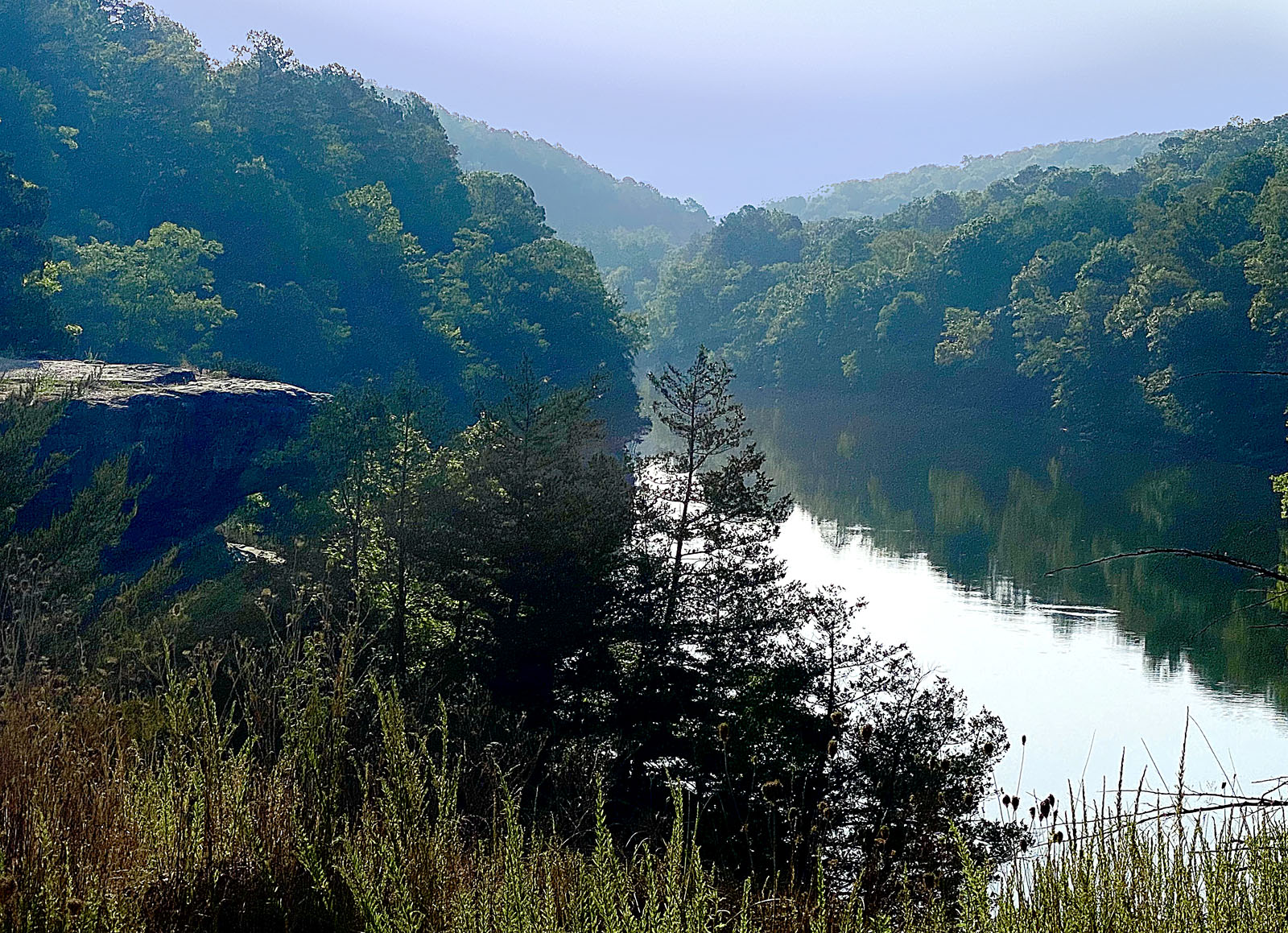
A view of Beaver Lake from our rental house
We had plenty of daylight left, so most of us explored the habitat surrounding the house to collect a few things. Richard, with the aid of Graham, strung up three white sheets for the upcoming evening’s blacklighting activities. Richard also placed a UV bucket trap out in a wooded area near the cabin. Typically, these passive traps run throughout the night and provide a great way to sample moths and other night flying insects.
It was apparent right away that this might not be as productive a trip as others due to extreme heat and historical drought conditions. Grasses and herbaceous vegetation were in many cases dried and withered, the soil and litter layer were dry, and in general insect activity seemed low, However, we did find ubiquitous groups such as butterflies, grasshoppers, ants, dragonflies, wasps, and bees. Native bees rely on flowers, which were in short supply at this time of year, but there were a few, and our bee expert Charles Ray did what he could to sample them. Charles is a treasure trove of information, and we were all amazed by his wide-ranging knowledge of many insect groups! Dragonflies of several species were in abundance as they patrolled edges that lead to the lake below. Ray Fisher, who lives in the area and coordinated our trip to the Ozarks, was extremely familiar with the local fauna, including the odonates, and he called out their names as though they were family. Ray is one of the most enthusiastic naturalists we have run across and his excitement concerning all organisms was contagious! Several species of grasshoppers were found in the immediate area, which pleased our orthopteran experts JoVonn Hill and Dan Otte, but the best catch of the entire week was the beautiful and rarely collected Melanoplus mcclungi that Landon found! The value of having experts of their caliber in field with undergraduates such as Landon and Graham cannot be overstated. These guys, as well as Zach, greatly benefited from the combined knowledge of them and the rest of the crew. It was wonderful to see the younger folks seeing things for the first time and sharing their excitement with the rest of us!
Our museum has a strong penchant for ants with JoVonn and I (MacGown) having studied these wonderful creatures for quite some time. Add Zach Brown, who is working on a master’s degree on ants in the central plateau region of Tennessee, to the mix and we had a good team of collectors. We typically find many of our ant species in soil and leaf litter, and we often use Berlese funnels to extract the ants. But with the dry conditions, our litter sampling productivity was severely hampered. We only ended up with 27 species (species list) for the trip, which was low compared to our other Cross expeditions. The most interesting species we found nesting near the cabin area were Pheidole soritis, a species we do not find readily back in our area and an undescribed species of Forelius that it widespread in our region but has not yet been described.
Joe Sweeney spent part of the late afternoon putting out dry oatmeal along areas he thought camel crickets would likely be dwelling, especially under some large rocky overhangs. As darkness fell, we perused the sheets to see what sorts of insects were being attracted by the UV lights and mercury vapor lamp. Some of us also wandered through some wooded areas with headlights looking for various arthropods. Ray led to some wonderful boulders with overhangs and openings. Camel crickets abounded there, as did numerous spiders including an Arkansas endemic wandering spider! Ray mentioned that most members of this group were highly venomous and restricted to the tropics. We even found a little family of pack rats tucked away in their craggy cave.
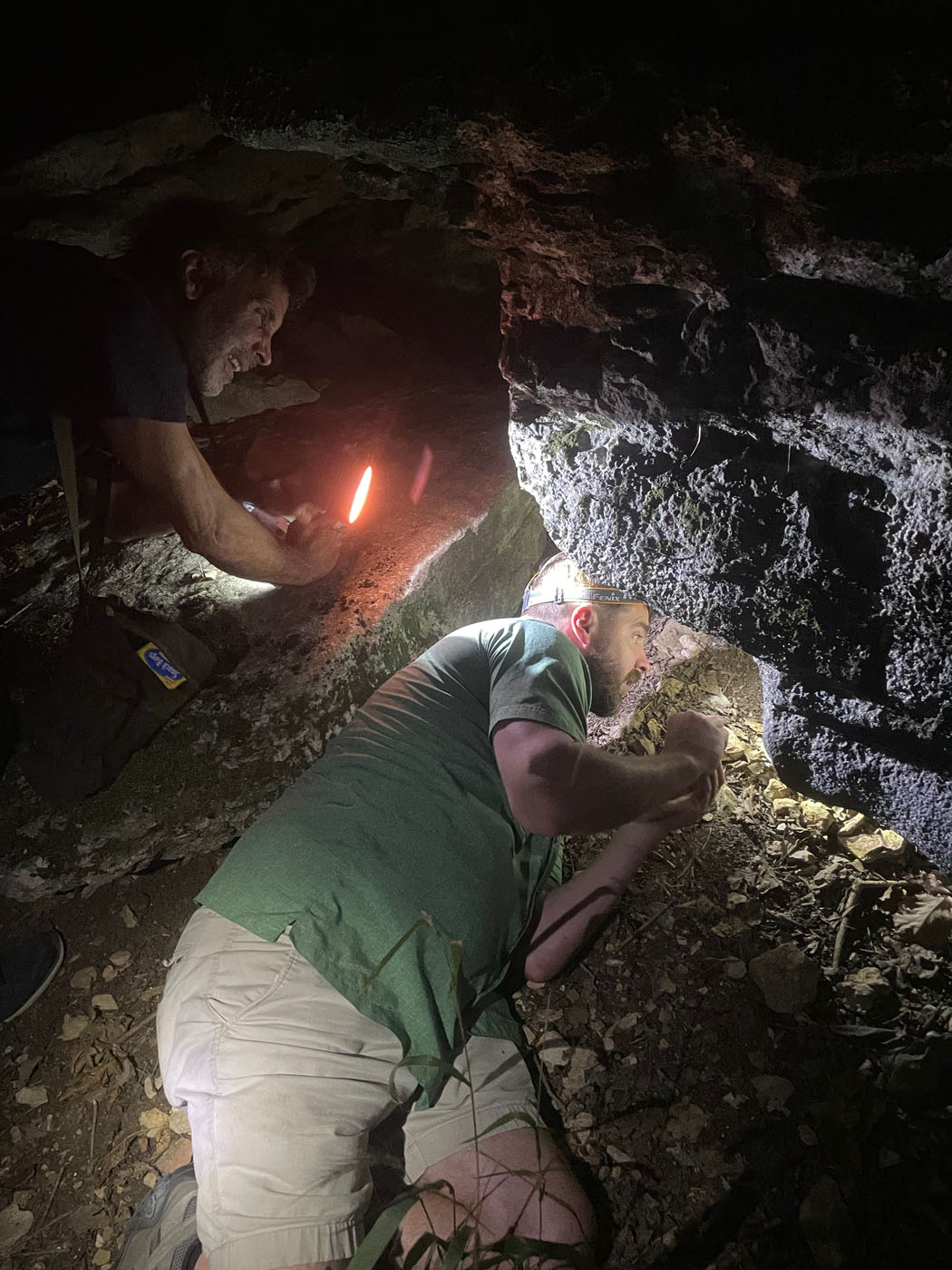
Joe Sweeney (left) and Ray Fisher looking for camel crickets and spiders
The sheets were not overly productive, although there were some larger beetles and enough moths for Richard to stay busy. As things slowed down, we called it a night and headed in to take care of our specimens.
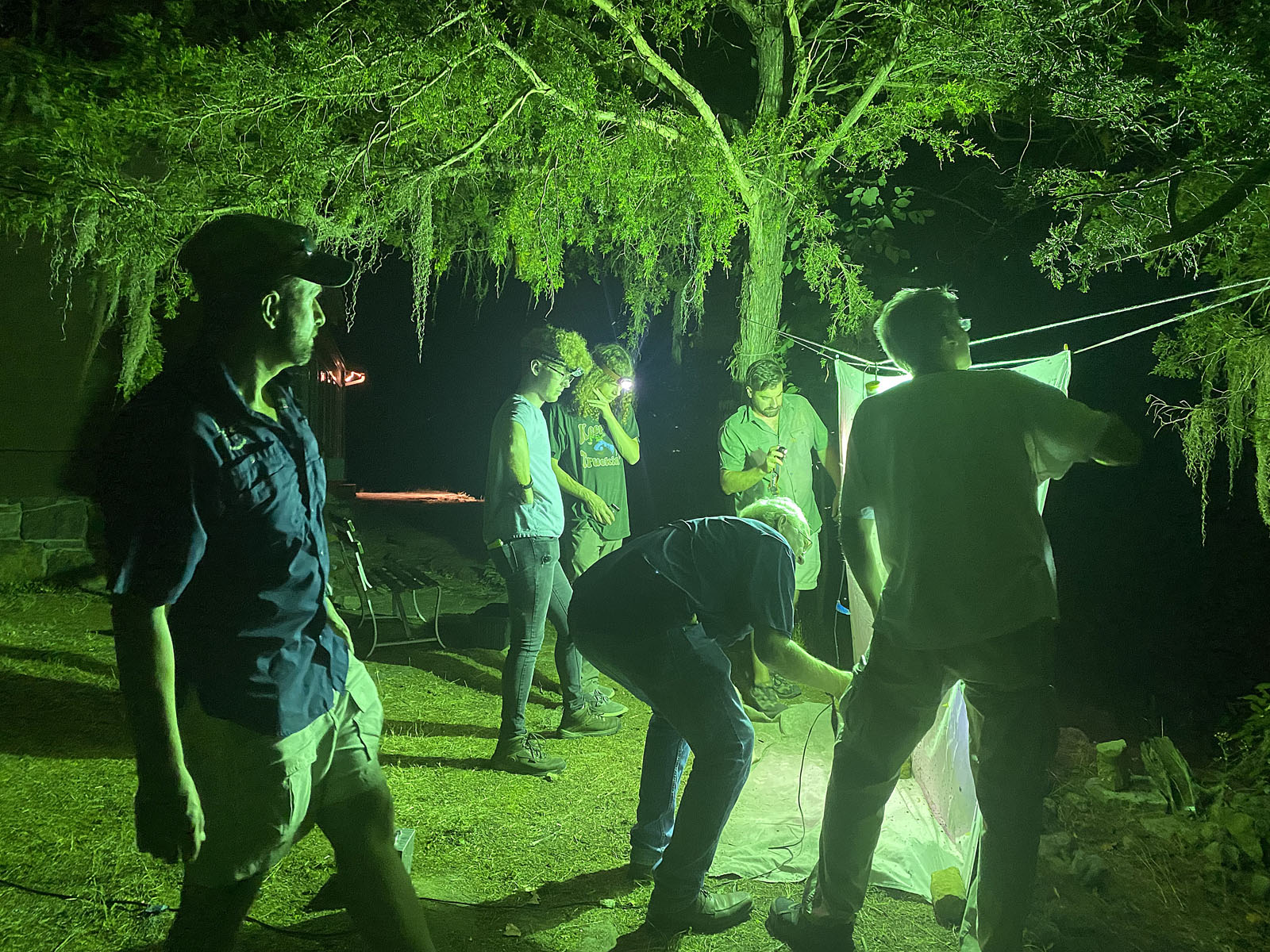
MEM Director JoVonn Hill looks on as Charles, Richard, Zach, Graham, and Ray collect at a sheet
Tuesday, 19 July 2022: Early the next morning, Richard retrieved the bucket trap and began the task of sorting through it. On occasions where insect activity is high, it can take a full day just to pull out the moths and put them into relaxing chambers to be pinned and spread later. However, like our other collecting, the bucket trap was not filled the brim. Despite smaller numbers of moths than usual, Richard found several species that are not widespread outside of Arkansas.
After scrounging around for breakfast related food items, we got in gear to start the day. Most of our sites were at least an hour away, so we wanted to get an early start before the heat set it. Unfortunately, the forecast for the entire week predicted temperatures over 100° each day, and there really was not a time of day or night when it was not hot. Dan and Joe (Sweeney) opted to stay at the cabin area that morning and then planned on scouting for cave sites. The rest of us including Ray, JoVonn, Zach, Charles, Landon, Graham, and I headed to a couple of sites in Newton County, Arkansas. Ray served as our guide for the trip. He also took care of lining up sites to collect and got us the necessary permits. Our first site was along the beautiful Buffalo River in the Buffalo National River Park. The water level was low, but during this drought it served as an oasis for many organisms.
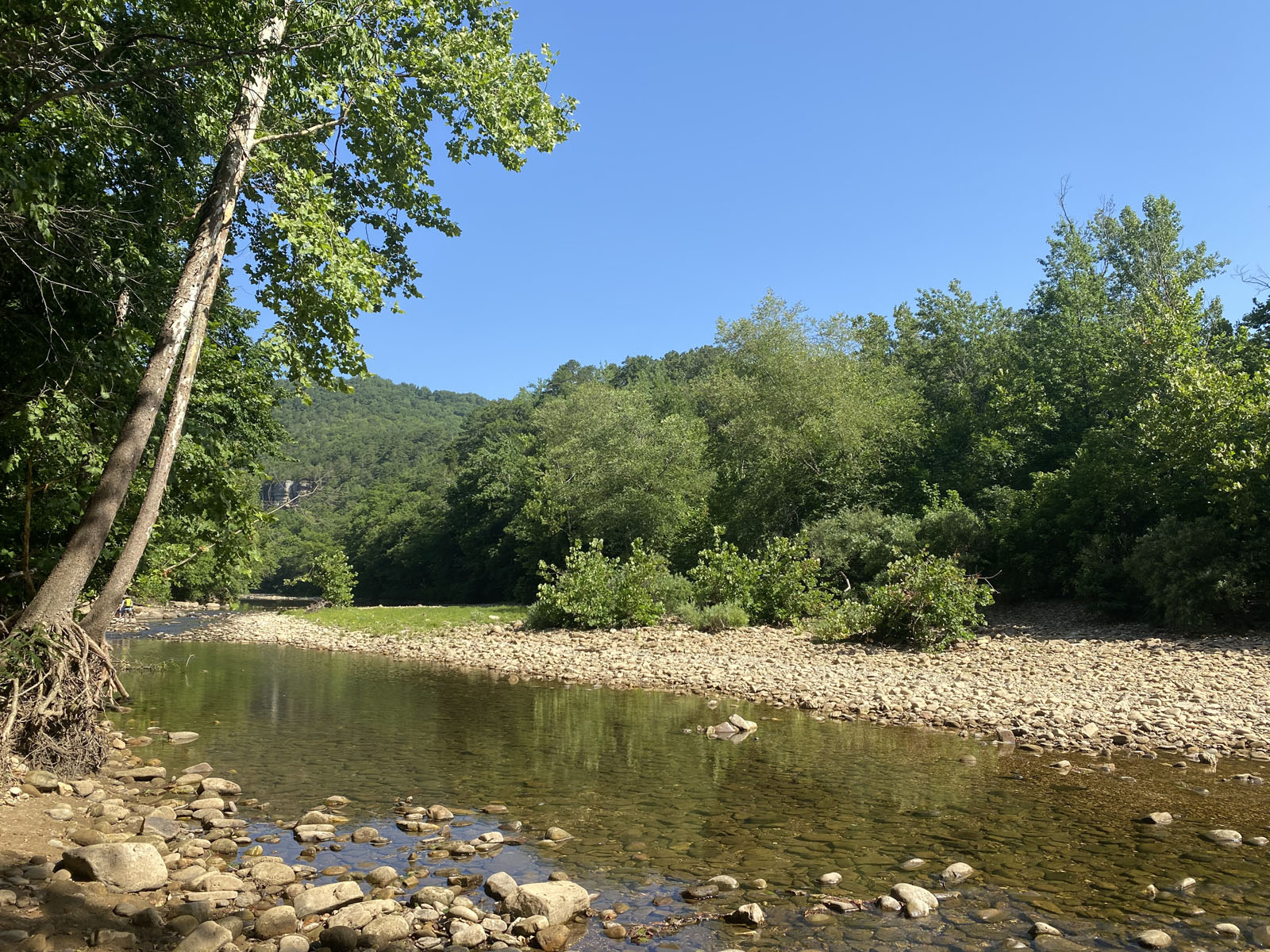
The gravel edged Buffalo River, very low water level
We found numerous beeflies, robberflies, sand wasps, and tiger beetles as they flitted about in the gravel edges of the river. A few flowering plants along the wood-line afforded Charles the opportunity to collect native bees. Grasshoppers were abundant in the grassy edges, and a single flowering button bush (Cephalanthus occidentalis) served as an island for wasps, bees, flies, and butterflies to nectar on. With the low water level, it was easy to view various small fish species. Additionally, Ray found a couple of young water snakes.
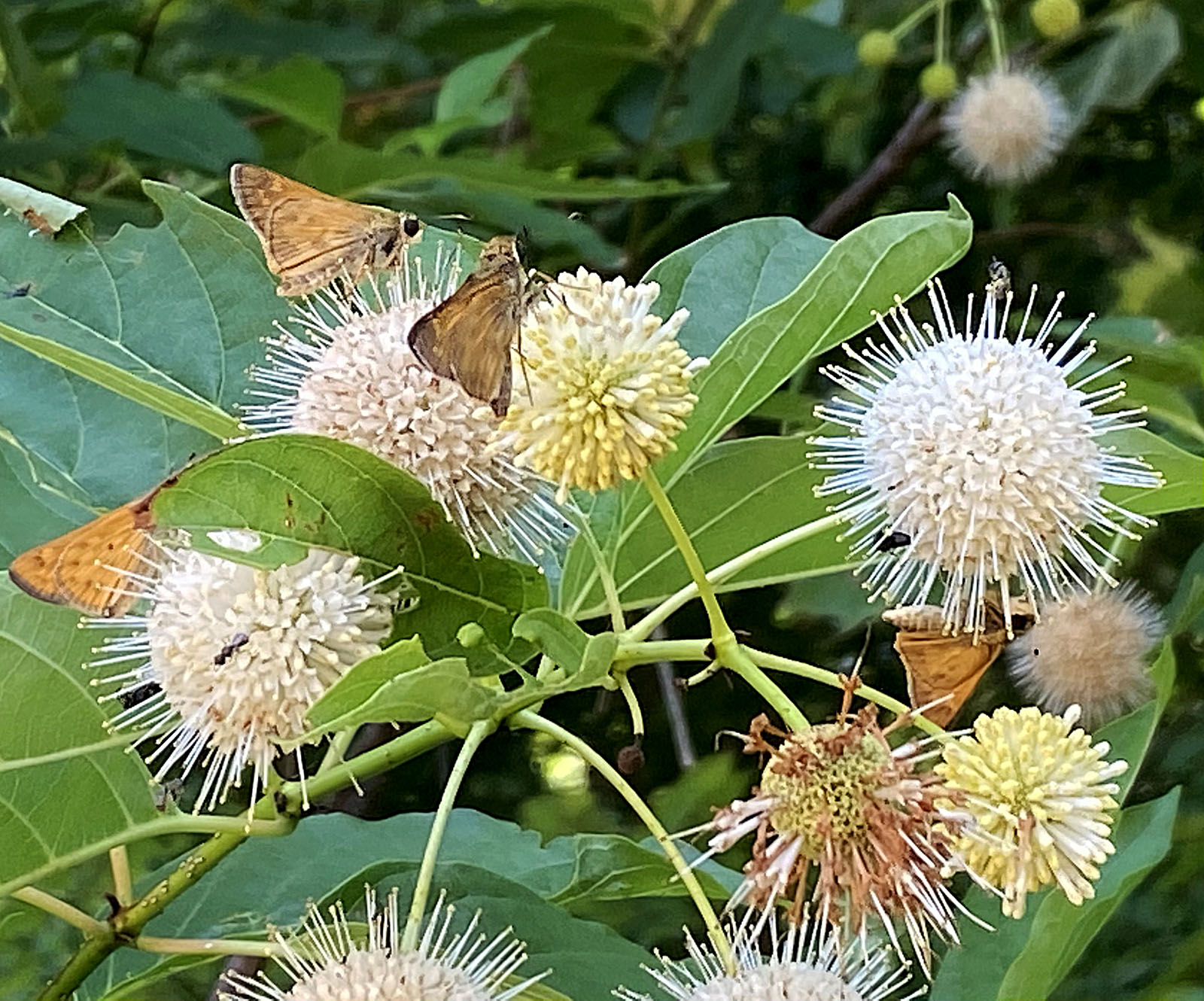
Butterlies, including these skippers, were in abundance on the button bush flowers
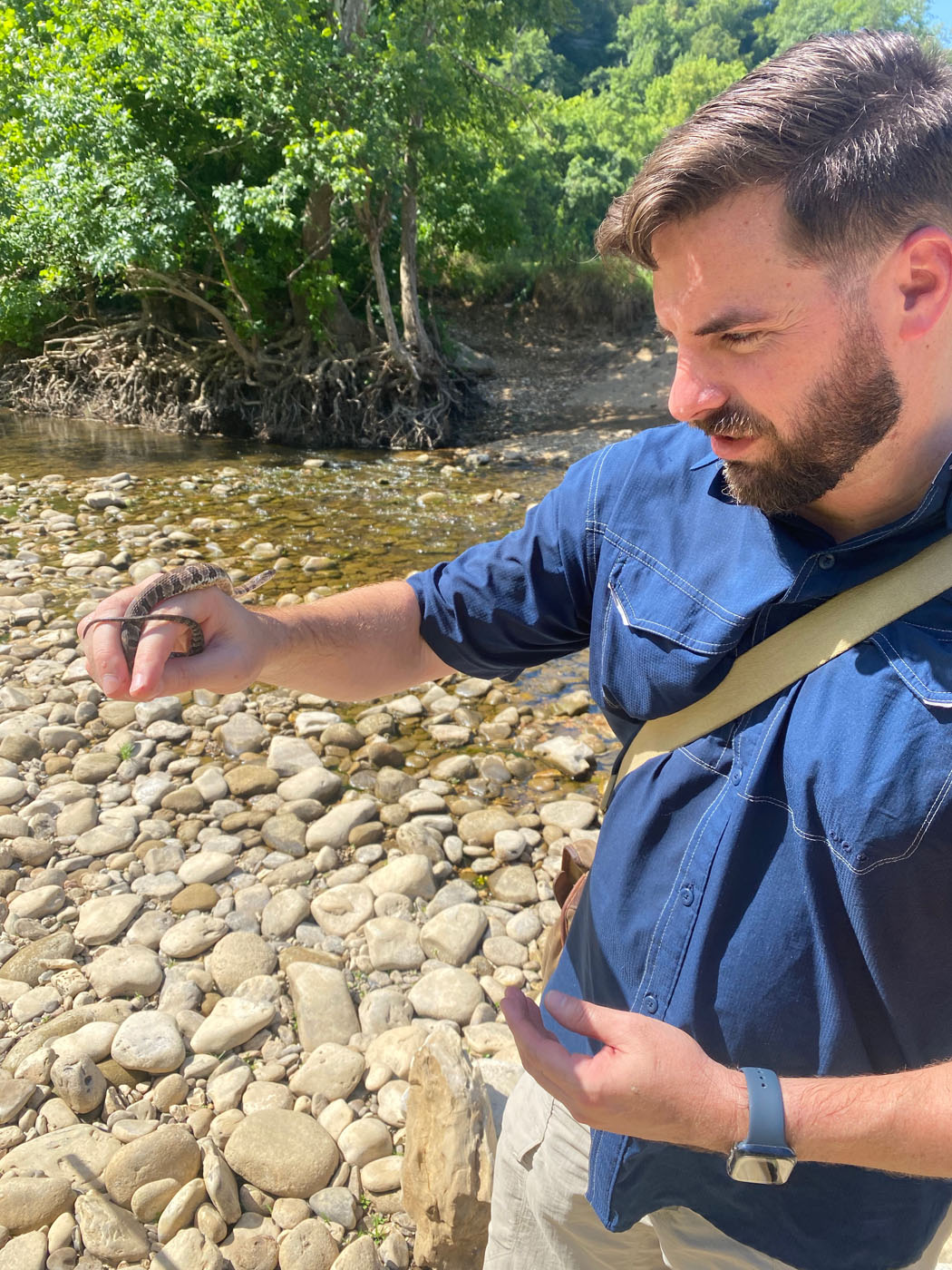
Ray showing us a young water snake
After an hour or so at this spot, we headed to a second site in this park. “Site 2” was a wonderful, sloped mountain trail that wound through a hardwood forest. While hiking up this steep trail we collected random insects that flew by, looked for ants and beetles in rotting wood, collected on vegetation, and grabbed a few litter samples to throw into Berlese funnels later. Similar to most of the region, this woodland was also dry, and we did not have high hopes for ant diversity in our litter samples. Our low expectations were realized as the ants that we collected that day and later extracted from the Berlese funnels were all ubiquitous species such as Aphaenogaster carolinensis, Myrmecina americana, Ponera pennsylvanicus, Strumigenys ornata, and S. rostrata.
We hiked for quite a while until coming to a dry creek bed, then we headed back and scrambled up the rocky mountain side to reach some glades that Ray was familiar with. He also showed an interesting mountain pond, which was teeming with life! We bushwhacked our way through the forest until finally hitting a steep paved road and jogged (two of us) or walked back to our trucks.
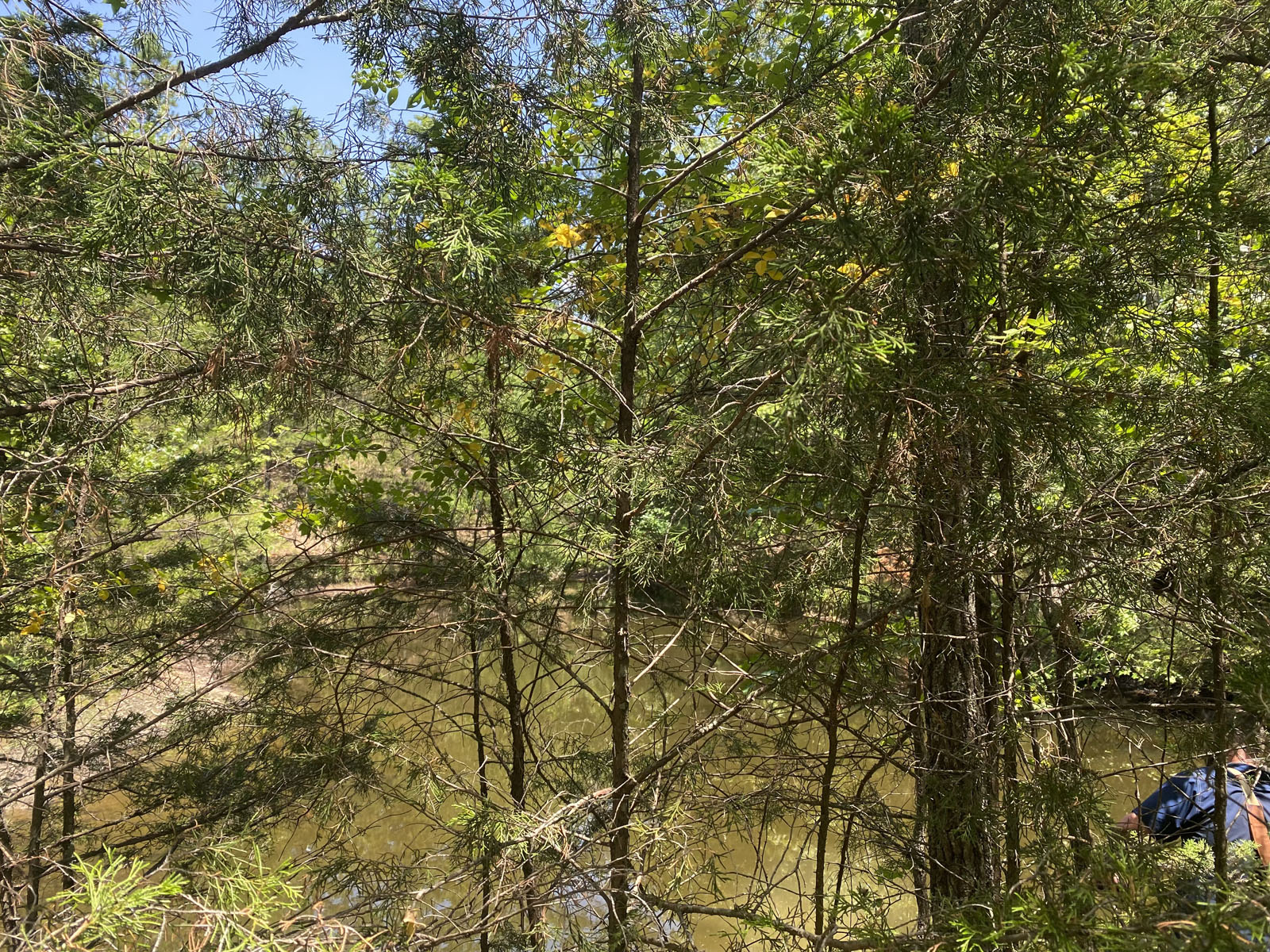
This pond was teeming with life!
Our next stop for the day was the Baker Prairie Natural Area in Boone County, Arkansas. This prairie site is but a small remnant left from a 5,000-acre tallgrass prairie. It is located beside a public school and along a highway in the small town of Harrison. A trail just over one mile long allows folks to explore the area without disturbing the vegetation. We were more than happy to see that this site was full of flowering plants and that foraging insects were in abundance! This was to be one of our most productive sites of the trip. In addition to the numerous bees, wasps, flies, and butterflies present, we also found ant species such as Crematogaster pilosa, Formica biophilica, F. subsericea, Monomorium minimum, and Pheidole dentata on the vegetation and/or foraging on the ground.
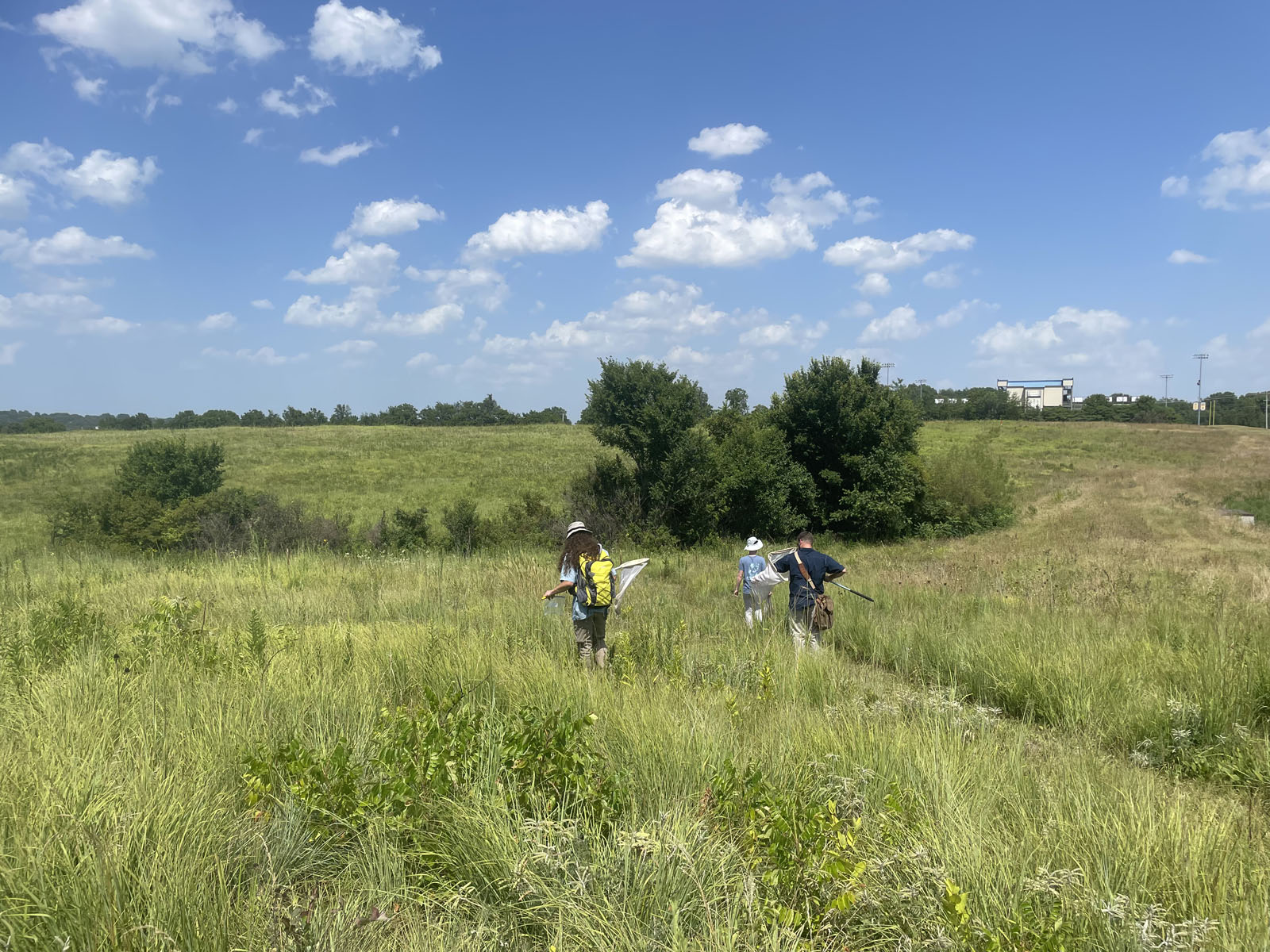
Landon, Zach, and Ray collecting at Baker Prairie

There were lots of rattlesnake master plants
Later afternoon, we departed from the Baker Prairie to grab food items from a Walmart and to get back to our cabin in time to blacklight. Because our sites were all relatively far from the cabin, we opted to do our night collecting at the cabin area itself for the entire trip. On previous trips, we typically blacklighted at different sites each night. Most members of this trip were of the day collecting variety, except for Richard, who is retired now and seemed happy to be collecting from the cabin area. Richard again placed a bucket trap out in the woods across the road from the property where we were based. Apparently, the catch was good enough that he wanted more.
After we had some supper type food, and it was dark enough, we headed outside to check out the insect activity at the sheets. For the most part, the primary sheet collectors were Richard, Landon, Graham, and Zach. The rest of us collected less intensely and worked on other things.
Wednesday, 20 July 2022: I got up early to catch the sunrise over the water and to work on a small watercolor painting. The scenic view overlooking the lake was quite inspirational. Richard once again was up early retrieving the bucket trap for sorting. His entire week involved night collecting, sorting bucket traps, and spreading moths! Such is the bane of the lepidopterist. It takes so much time spreading moths, which is easiest when they are freshly collected, that it is difficult to find time to visit the interesting habitats during the day. With the extremely high temperatures, being inside an air-conditioned house was not a terrible thing, and today was slated to be the hottest day yet! Our first site of the day was Coy Bald located in the Hercules Glade Wilderness Area in the Mark Twain National Forest in Taney County, Missouri. This Wilderness Area is over 12,000 acres and hosts a variety of habitats such as open grassland, forested knobs, steep rocky hillsides, narrow drainages, and limestone rock outcroppings.
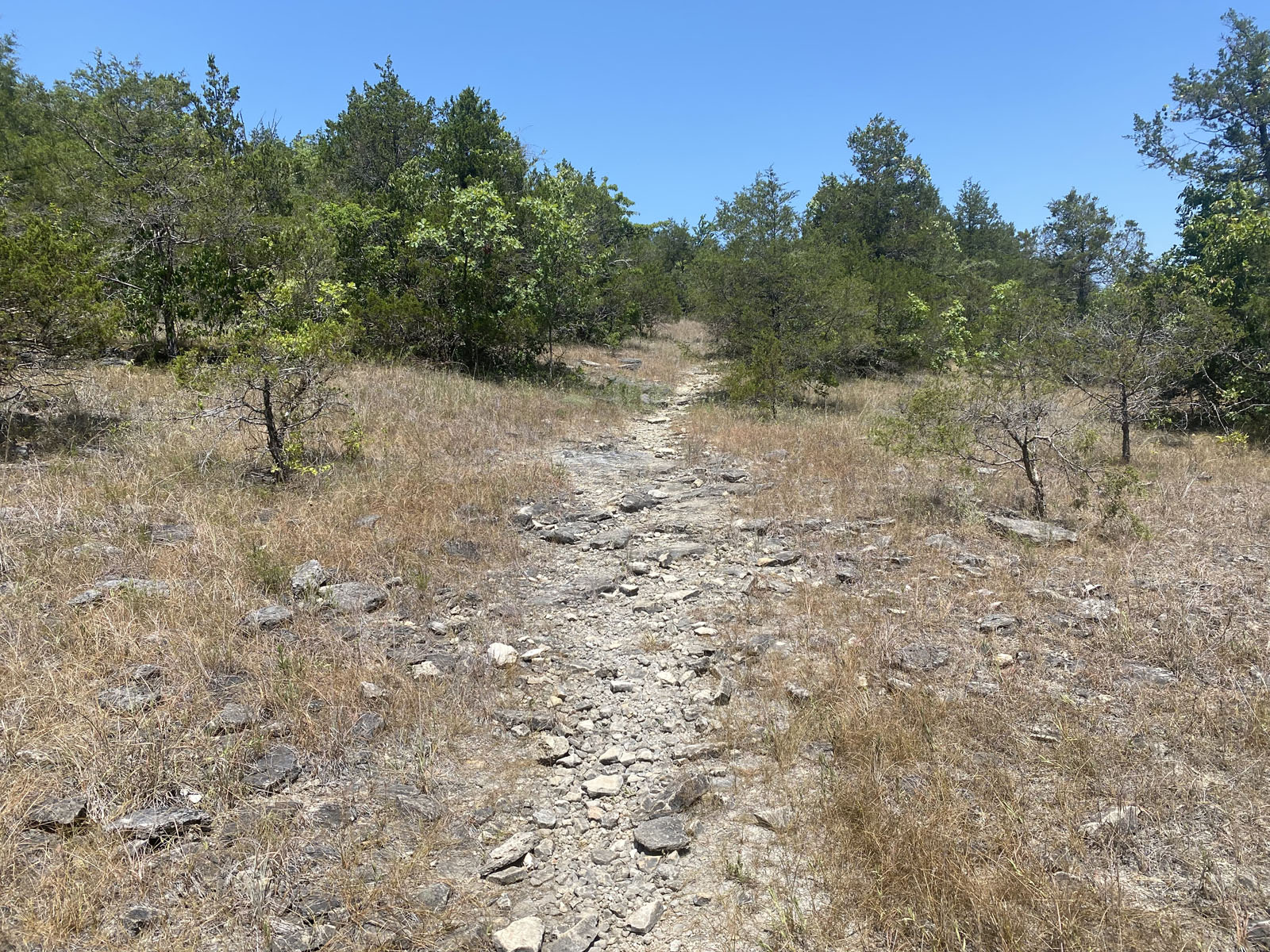
The Coy Bald area was super dry!
This site was two hours away, so we got on the road as soon as possible to hopefully arrive before it was too hot. This was a great idea in theory, but it was already hot at 7 am and by the time we arrived at Coy Bald it was 109° F! Wowzers! We had the same crew as the day before, and as soon as we arrived, we started out on the trail to the bald. Ray mentioned that typically this site had some very interesting species of insects such as Lasia purpurata, a beautiful, large metallic green small-headed fly (Acroceridae). We did see several species of bee-flies in shaded areas and tiger beetles along the trail, but the dryness of this ridge was obvious with desiccated grasses and no flowers to be seen. The highlights of the area were scorpions and tarantulas, but even those were hard to come by and mostly hunkered down deep. Ray managed to find a gorgeous female Texas brown tarantula and a female striped bark scorpion Centruroides vittatus) laden with immatures on her back!
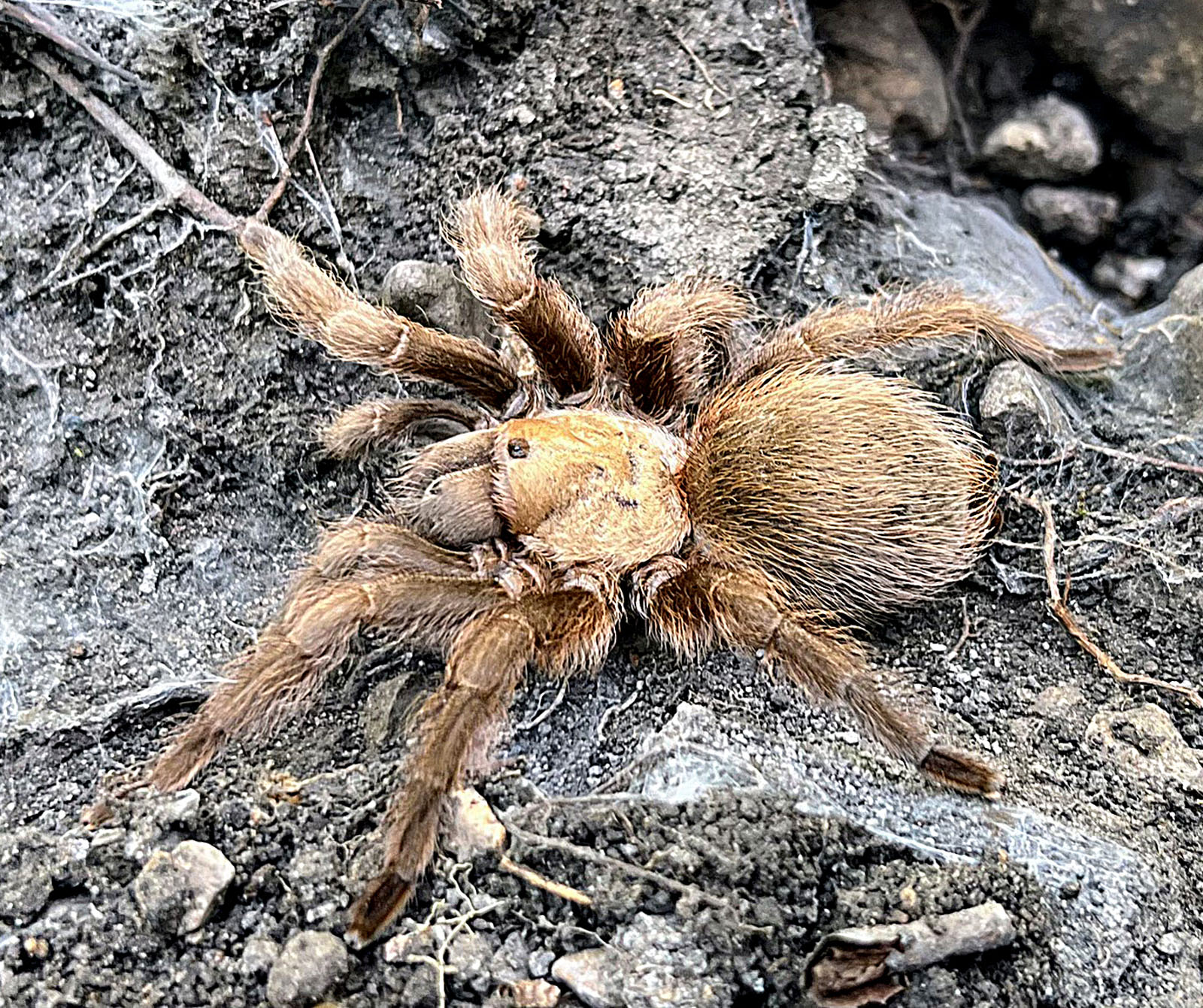
Ray Fisher snapped this photo of a Texas brown tarantula!

A female striped bark scorpion with young on her back (photo by Ray Fisher)
We roamed around the site for quite some time before the heat started to sap us. We began our journey back to Arkansas. Along the way we passed through Branson, MO, a tourist destination and stopped to collect at the nearby Ruth and Paul Henning Conservation Area. This 1,534-acre area is in the White River Hills of western Taney County just west of Branson and consists of steep hills with upland oak/hickory forest with several glades interspersed. Ray led us to a forested area beside the beautiful Roark Creek with its gravel/sand bars. The woodland trail was elevated a couple of meters about the creek, and like other sites, it was very dry. Charles spent much of his time wandering down the creek itself looking for pollinators. The rest of us spent most of our time collecting in the shady wooded trail.

Roark Creek, at the Henning Conservation Area
While in the Branson area, we found a Mexican restaurant to eat at. Mexican food has become a tradition on our Cross trips, so this was perfect! Eating late in the day, especially after being out in the hot sun, sure made us lazy, and as for myself, I was happy to have Ray drive the almost two-hour journey back!
The evening was very similar to the past two nights, with off and on collections at the sheets. Richard and Ray set the bucket trap up before dark at a site in nearby Hobbs State Park. By the time they were back to the cabin, Landon and I had cooked up some burgers and sausages on a pellet grill we found out back. Neither of us had used this type of grill, so it was an adventure! After dinner and following our nighttime collections, we called it a day.
Thursday, 21 July 2022: I was up early again and outside working on some art. I always take a few little pieces to work on and also typically do a few studies of the places we visit. Richard was up fairly early and grabbed the bucket trap from Hobbs State Park. He had placed it in a hardwood forest and was hopeful for another good catch of moths.
As the rest of the crew stirred about, smacked down some coffee and ate odd bits of available food, we jumped into a couple of trucks for another full day of collecting and exploring. We had the same crew again with the addition of Joe Sweeney. Our first stop was a shale barrens site at Kessler Mountain Reserve in Washington County, Arkansas. Accessing the site required a decent trek through hilly wooded trails. Part of the group headed straight for the barrens, while the others collected along various forested trails before rejoining us a couple of hours later.
It was another scorching day and our insect collecting efforts were not overly fruitful. But the barrens area was well worth the hike. This open woodland featured stunted blackjack, chinquapin, and post oaks growing out of the ancient shale soil. There were not a lot of flowers at this time, so we spent much of our time flipping larger pieces of shale and looking under logs for insects and other arthropods. Ray found a tarantula and scorpion under the first rock he flipped! But overall, we did not see much activity likely due to the unusually dry conditions.

Milling about looking at insects while waiting for Charles and Graham
After collecting at the barrens, we headed back to meet up with Charles and Graham and loaded up. Our next stop was the Chesney Prairie Natural Area located in Benton County, Arkansas. To access the site, we drove down a farm road with chicken houses. The prairie was quite different than Baker Prairie with less apparent plant diversity and certainly less plants in flower. It was much drier there than at Baker Prairie also. We hiked the “bush-hogged” paths that had been cut around and through the prairie, sweeping and collecting on the flowers that were present, including scattered sunflowers. Although it was not as productive as Baker Prairie, we found plenty of bees, wasps, grasshoppers, and few ant species.
We finally called it quits and decided to make a stop in the scenic small town of Eureka Springs to eat something and to see what this artsy town had to offer. We found a unique diner that featured Cajun food and eclectic art. It was a fun meal with a great owner/host. After eating we strolled through the Main Street area ducking into shops for ice cream, coffee, and to see interesting art. It was a cool little place, but it was time to get back to the cabin to take care of specimens and prepare for night collecting.
This was our last night of the trip, so we were more casual with our collecting. We still had three sheets up and running and folks randomly collected at them. Some of crew began packing supplies so we could make an early morning retreat. It was a nice evening for conversations as we pinned material, entered data, and did other activities.
Friday, 21 July 2022: This was our final morning of the Cross Expedition. Charles, Zach, Landon, Graham, and I loaded up in two trucks to head back to Mississippi. Dan and Joe departed on a journey farther west and north to search for camel crickets and grasshoppers. JoVonn spent the day with Ray collecting grasshoppers for a large project he is working on. He later mentioned that they stopped at Searles Prairie, which he said was similar in plant diversity to Baker Prairie. Richard Brown was headed to Portal, Arizona, where he would be helping lead a Lepidoptera workshop. The Starkville bound group arrived later in the afternoon, and after unloading and putting specimens into the freezer, we were ready to be home!
William H. Cross Expedition Collecting Sites
Cabin at Beaver Lake (BL & MV at sheets, general collecting, 18-22 July 2022)
USA, ARK., Carroll Co.
Packard Springs Twp.
36.3120 -93.8209
hardwood forest
near lake
Buffalo National River Park Site 1 (near river, 19 July 2022)
USA, ARK., Newton Co.
Buffalo Natl. River Park
36.0386 -93.3354
forested habitat
along river
Buffalo National River Park Site 2 (19 July 2022)
USA, ARK., Newton Co.
Buffalo Natl. River Park
36.0403 -93.3400
hardwood forest on
mountain slope
Baker Prairie (19 July 2022)
USA, ARK., Boone Co.
Baker Prairie
36.2432 -93.1339
prairie
Coy Bald in the Mark Twain National Forest (20 July 2022)
USA, MO., Taney Co.
Hercules Glades W.A.
36.6852 -92.9596
bald
Henning conservation area (20 July 2022)
USA, MO., Taney Co.
Henning Conserv. Area
36.6835 -93.2873
mixed forest near creek
Chesney Prairie (21 July 2022)
USA, ARK., Benton Co.
Chesney Prairie N. A.
36.2187 -94.4822
Prairie
Kessler Mountain (21 July 2022)
USA, ARK., Washington
Co., Kessler Mtn. Res.
36.0219 -94.2178
Shale Barrens
Hobbs State Park (Box Trap)
USA, ARK., Benton Co.
Hobbs State Park
36.2909 -93.9302
hardwood forest
Searles Prairie N.A. (J. G. Hill, R. Fisher)
USA., ARK., Benton Co.
Searles Prairie N.A.
36.3569 -94.1431
22 July 2002
prairie





